- Izu Peninsula top
- General
- Earthquake and volcano
- Too many deer in Izu
- East
- Ito - its old buildings
- Anjin = Wlliam Adams and Ito
- Religious Charisma Nichiren
- Washtub race
- Yokikan - Spa ryokan
- Minami-Kaikisen: Auberge
- Ike and its paddy fields
- Summer has come!!!
- Inatori - fish, spa and more
- Central
- Banjo Waterfall
- Mount Amagi
- Shuzenji - old spa town
- Arabashiri - Bandai-Jozo
- Oomi Land - heart of Izu
- West and south
- Heda on the west coast
- Toi - Gold mine
- Matsuzaki - namako wall
- Izu-no-Chohachi - Plasterer
- Kumomi on the west coast
- Shimoda - Tojin-Okichi
- Cottage life
- Fishing in Usami
- Start of my fishing life
- Training camp in Amagi
- Cottage life / music&drinks
- Party in Izu - part 2
- Party in Izu - part 1
- Sunday morning concert
- Ice and snow in Amagi
- My summer house
- Restaurant and eatery
- Let’s eat Izu-Deer!
- Isui-an - exquisite soba
- Sugizen - big prawn fry
- Sayang - Bali restaurant
- Restaurant Tanaka
Inatori - fish, spa, hanging hina and much more
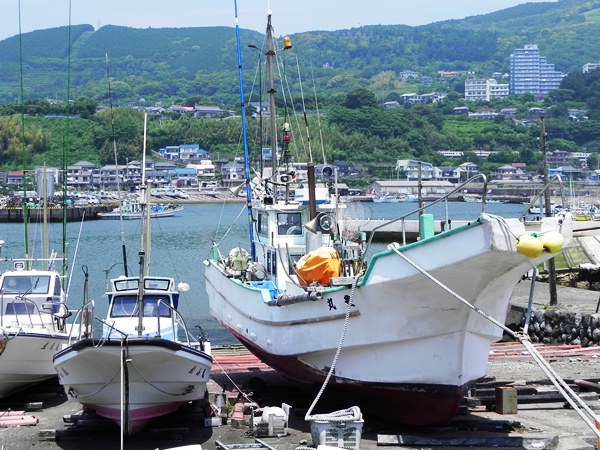
Inatori fishing port seen from the entrance of Tokuzomaru restaurant
 First of all, Inatori is a fishing town and renowned for its especially delicious kinmedai (splendid alfonsinos). Shimoda can boast the volume of kinmedai landed at its port. However, gourmets say that the kinmedai landed at Inatori tastes better and I believe that there is a reason for this judgment.
First of all, Inatori is a fishing town and renowned for its especially delicious kinmedai (splendid alfonsinos). Shimoda can boast the volume of kinmedai landed at its port. However, gourmets say that the kinmedai landed at Inatori tastes better and I believe that there is a reason for this judgment.
We can eat kinmedai from Inatori in many places including Ito, say at Tanaka. However, we wish to relish fresh fish just after landing and Tokuzomaru is in the best location for fulfilling such a dream, because it stands next to the fishing port of Inatori. The founder of the restaurant was a kinmedai fisher and the name Tokuzomaru came from his fishing boat. Tokuzomaru also sells fresh fishes in the shop on the ground floor and both shop and restaurant are always filled with tourists.
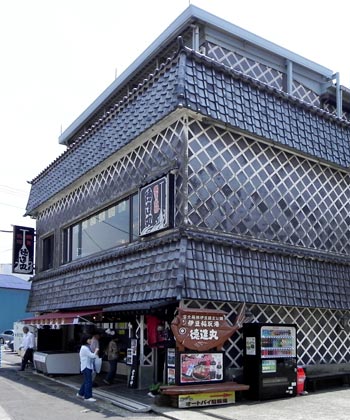
Tokuzomaru
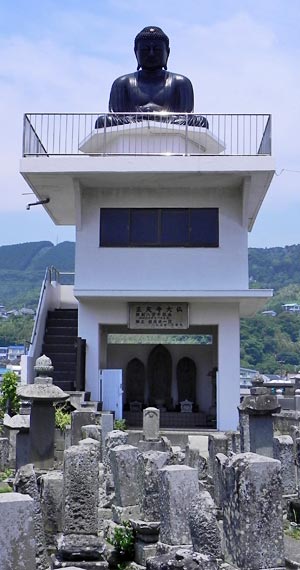
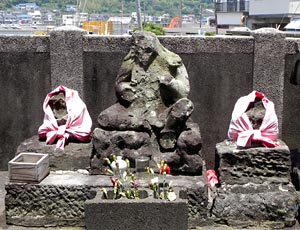
Yaobikuni (center)
There are some interesting things in the neighborhood of Tokuzomaru. There is a stone figure, for example, standing only a few steps away from the fish shop. It is badly eroded and hardly identifiable. However, according to tradition, it is a statue of "Yao-bikuni".
 "Yao" is eight hundred, and eight hundred is a symbolic expression of a very big number. "Bikuni" is a Buddhist nun. Yao-bikuni was a nun who had lived 800 years, because she happened to eat the flesh of mermaid, which her father happened to bring back home. She acquired immortality and continued a lonely life as wandering nun. Yao-bikuni is here worshiped as a goddess to protect the commune from invading evils at its border.
"Yao" is eight hundred, and eight hundred is a symbolic expression of a very big number. "Bikuni" is a Buddhist nun. Yao-bikuni was a nun who had lived 800 years, because she happened to eat the flesh of mermaid, which her father happened to bring back home. She acquired immortality and continued a lonely life as wandering nun. Yao-bikuni is here worshiped as a goddess to protect the commune from invading evils at its border.
From Yao-bikuni, we can see a strange landscape. A large Buddha statue sits on a two story concrete house. The statue was built in 1985 to commemorate the 800 years' anniversary of Shojoji Temple. There are many old grave stones in its court. The contrast between old grave stones covered with moss and a tasteless concrete house with a large Buddha statue on top of it is somewhat awful. However, we have to give them understanding, because the temple supporters appearently tried to protect Buddha from natural hazards such as typhoon and tsunami.
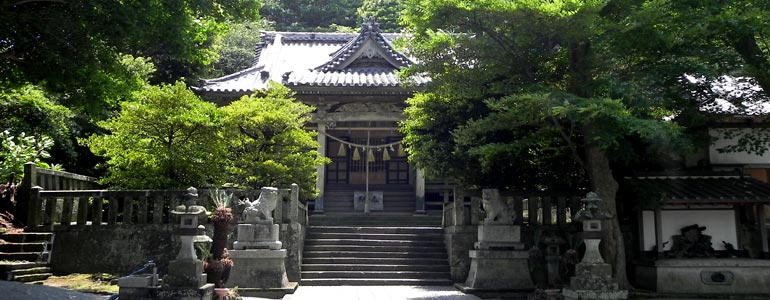
Hachiman Jinja
Shojoji has a legend that Minamoto no Yoritomo (1147-1199), the founder of the first samurai government "Bakufu" paid a visit to the temple. He is also said to have visited Hachiman Jinja and prayed for the victory over the Heike clan which was then in power.
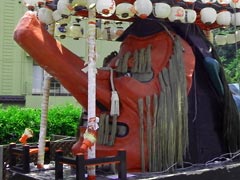
Tengu float
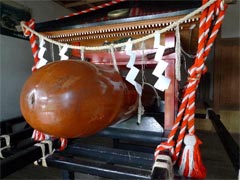
Goshintai in the mikoshi
(portable shrine)
Though Inatori, like other areas of Izu, was inhabited since the Paleolithic time period all through the ancient time of Japan, it was only in the periphery of the Japanese history and we do not know much about ancient events Izu.  Izu came into the limelight first as a place to banish political criminals and Yoritomo was banned to Izu as a son of the defeated rival clan.
Izu came into the limelight first as a place to banish political criminals and Yoritomo was banned to Izu as a son of the defeated rival clan.
Behind the prestigious Hachiman Jinja, a small shrine stands on top of the highest hill of the Inatori Peninsula. Dontsuku Jinja is famous for its strange festival. Its "goshintai", symbol of the deity, is a three meter large penis shaped object. In the evening of its annual festival, goshintai marches through the streets. According to tradition, Dontsuku festival was introduced by the rice cultivating immigrants about 2000 years ago for the sake of fertility, good health and well-being of the family. I happened to be there on the day of the festival. However, I came back home before evening when the festival took place. Mikoshi and floats were still waiting for the start of the festival.
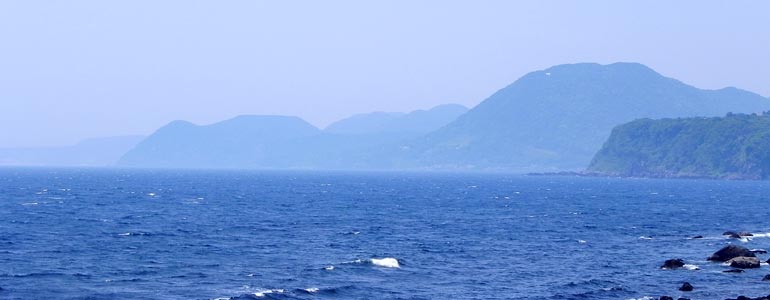
The landscape seen from the south coast of Inatori
The southern coast of Inatori Peninsula is densely covered by spa hotels. A thermal well was discovered in Inatori as late as in the 1960s. However, onsen and related tourist business forms nowadays the kernel of the Inatori's economy. While fishery constitutes only 1% of the total income of the inhabitants, tourism makes up more than 80%.
Inatori has invented many things to attract tourists. "Tsurushi kazari" (hanging ornament) is also a new invention or a new discovery. "Hanging hina" for hina-matsuri (girls' day) has about two hundred years' tradition in Inatori. Hina dolls were very expensive and only rich people could afford them. Mothers and grand-mothers in Inatori nevertheless wanted to celebrate the first girls' day of their beloved daughter or granddaughter and started to hand-make stuffed ornaments at the end of the Edo period (1603-1867). Two other places in Japan, namely Yanagawa in Kyushu and Sakata in Yamagata have a similar tradition.
The tradition came to be forgotten, as the living level rose in the 1960s. However, the people of spa hotels in Inatori started in the 1990s to revive this tradition and make it a tourist attraction. After a successful decade of commercialization of hanging hina, they recently came up with a new idea to hang ornaments also on 5th May, boys' festival. I believe, hina-matsuri is of course only for girls and takes place on 3rd March, which is still too early for tourism in Izu, but May is already the high season.
A museum for hanging ornaments "Hina no Yakata" opened last January in the center of Inatori town. We can see old samples and gorgeous hinas as well as related information. Though, the tradition of tsurushi-kazari was revived for the sake of tourism, I find it really a good idea to revive this cordial family tradition. (Tsurushi kazari is often used as a decoration for restaurants and hotels. Here is an example of Sugizen.)
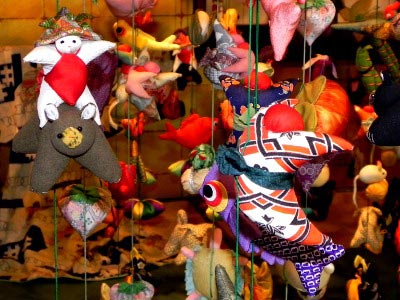
Detail of a boys' day ornament
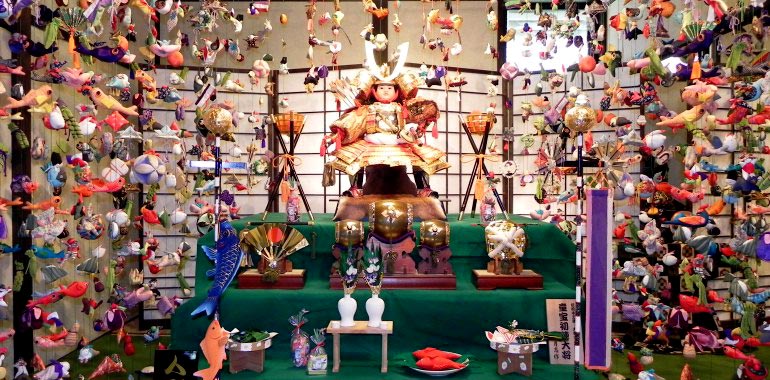
Hanging ornaments to show up a samurai figure for the boys' day
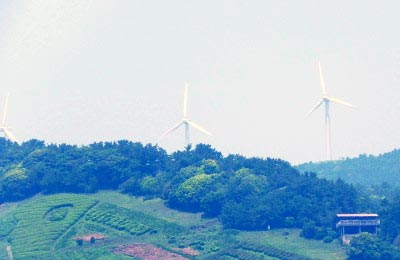
Three windmills in Inatori
Inatori has indeed various tourist attractions. There is a safari park and visitors can see white tigers, lions, giraffes, rhinoceros and many other animals. There are also a golf course and tennis courts. But, Inatori has more.
I find it unique for a Japanese municipality to use clean energy to attract visitors. Inatori invested more than 500 million yen (some 6 mil US$) to build three windmills, utilizing subsidies from the central government amounting about 50% of total cost. The windmills started operation in 2004. The municipality government explains that the windmills bring 50 million yen (600 thousand US$) income to the community by selling the generated electricity to TEPCO and that they also attract tourists.
In FY 2010 the total power production was 3.9 gwh and brought some 38.8 million Yen (500 thousand US$) to the municipality. Roughly speaking the generated electricity could meet the electricity consumption of some 700 households. As there are 2,901 households in Inatori in May 2012, thee windmills could cover one forth of the household electricity consumption of Inatori.
It is not easy for me to judge only from public information whether of not the project is successful both from economic and environmental viewpoint. In the meantime there is a much bigger windmill project in the eastern Izu and there are of course protests from the part of inhabitants by reason of nuisance to the environment. The accident at Fukushima Nuclear Power Station might have changed the atmosphere surrounding the discussion.
Anyhow, despite various kinds of efforts, the population of Higashi-izu municipality, to which Inatori belongs, keeps declining since the mid 1980s. At the peak period it was more than 17,000 people. But, now only about 14,000 people live in this municipality and the aging of inhabitants is an irresistible trend as in other places of Japan. We see many shops closed with shutter in the main streets of Inatori - a cityscape we often see nowadays everywhere in Japan. A regular ship line was suspended between Inatori and Oshima, the largest island off the Pacific coast. Inatori makes good efforts to vitalize its community, I know, but it needs more idea and efforts to reverse this downward trend.